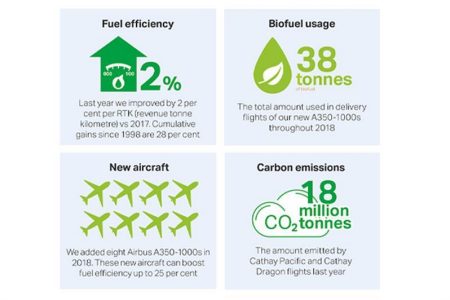For airlines, this creates an immediate and obvious challenge, and also indirectly impacts companies that use aviation as part of their supply chain. Jet fuel is a limited resource, and each tonne burned creates a tonne of CO2 emissions – one of the major contributors to climate change. Last year, Cathay Pacific Group aircraft generated 18 million tonnes of CO2 emissions.
Currently, aviation is only responsible for between two and three per cent of emissions worldwide, but that share is set to grow as the industry expands, particularly in Asia. The aviation sector is establishing targets to combat climate change, led by the following initiatives:
Achieve carbon-neutral growth from 2020 through capping of net emissions
By 2050, lower net emissions to 50 per cent of the levels recorded in 2005
Progress is already being made. For example, each new generation of aircraft being made – such as Cathay Pacific’s Airbus A350 – offer fuel economy savings of 15 to 20 per cent over the aircraft they replace. Cathay Pacific Climate Change and Biofuel Manager Yee Chow says: ‘We have reduced fuel use on a unit basis by 28 per cent since 1998, through the introduction of new fuel-efficient aircraft and other operational improvements.’
However, with the number of air passengers set to double by 2035 and significant advancements still to be seen in developing electrically powered aircraft, Chow says there is ‘a widening gap that current technology can’t yet close.’
Airlines will establish carbon emissions targets from 2020, with a two-pronged strategy: developing sustainable aviation fuel (SAF) such as biofuel, and buying carbon credits at an airline level to offset emissions that go beyond the agreed cap.
Cathay Pacific has been addressing this since 2008, when it first got involved in developing a global plan to regulate airline emissions. The new regulation – CORSIA (Carbon Offsetting and Reduction Scheme for International Aviation) – will effectively cap international aviation’s carbon emissions growth at 2020 levels, with any additional growth being compensated by the purchase of carbon credits.



